SPWLA publication using PLATO-AT
Publication from BP using PLATO-AT
PLATO-AT has been used to provide flow rates from array PLT data analsysis in a recent SPWLA publication with authors from BP.
A NEW APPROACH TOWARDS PETROPHYSICAL SURVEILLANCE IN A GIANT NORTH SEA FIELD
Download link
https://www.spwla.org/SPWLA/Publications/Publication_Detail.aspx?iProductCode=SPWLA-5059
Abstract
Petrophysical Surveillance in Clair Field faces challenges due to reservoir properties, fluid properties, completion design and limited technology offers. Low porosity, low salinity reservoirs under waterflood recovery, coupled with high angle – horizontal wells completed with sand face valves limits the ability to log for saturation monitoring. The wells are packer segmented between major flow units, making it difficult to assess the inflow profile from individual units (sand bodies) and almost impossible to differentiate matrix from natural fractures contribution. The presence of heavy fluids (completion or asphaltenes) pose further challenges to conveyance and frequently affects the sensor responses. A surveillance campaign conducted in 2019 lead to significant improvement, with results that helped us better understand the reservoir and wells behaviour and change the surveillance strategy.
There were several different elements that we considered which led to successful results. Candidate selection is important for saturation monitoring. For the specific environment of the field we found that access to logging while drilling data (baseline capture cross section) is critical. This will also be considered for data acquisition in the remaining infill wells to be drilled. A different approach was taken for flow diagnostic in terms of sensors selection and data acquisition procedure. Generally, there is a limit on rig up height, hence a need for short tool-strings. Access to short tool-strings is also important in data gathering due to better sensors collocation and less flow disturbance, translating into a more representative downhole measurement. A tandem string of both new compact flow diagnostic sensors and traditional production logging sensors was deployed. The traditional sensors failed due to harsh well conditions while the compact system delivered reliable results without mechanical failures. One major achievement was the value we extracted from Doppler shift measurements, demonstrating that in this specific environment they can replace mechanical spinners. The compact flow diagnostic tool enabled us to change the acquisition program, reducing the logging time. This translates to less risk, less production deferment and less wear to sensors. A new multidetector pulsed neutron tool with surface and memory read out capabilities was deployed for first time in Clair field. The data proved useful to monitor the saturation change and to complement the flow diagnostic behind pipe. It also helped us to understand the dynamic behaviour of fracture vs matrix.
The paper will describe the new surveillance approach, the sensors response and the results impact on our field management strategy.
Authors
Tracey Vaitekaitis, Adrian Zett, Alexandra Love, Shakeel Ahmad, Alwin Noordermeer, Gerardo Cedillo and Xiaogang Han. BP




